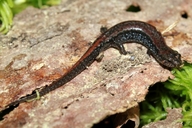|
Desmognathus auriculatus (Holbrook, 1838)
Southern Dusky Salamander | family: Plethodontidae subfamily: Plethodontinae genus: Desmognathus |
 © 2022 Nathan Vaughan (1 of 11) |
|
|
|
Description The larvae are brown to almost black in color. The throat and belly are clear, and they have a row of spots down the center of the back to the tail (Ashton and Ashton 1988). Distribution and Habitat Country distribution from AmphibiaWeb's database: United States U.S. state distribution from AmphibiaWeb's database: Alabama, Florida, Georgia, North Carolina, South Carolina, Texas, Virginia
The Southern Dusky Salamander is chiefly found in on the outer Coastal Plain, from southeastern Virginia to central Florida, and also from western to eastern Texas. In Florida, this salamander can be found westward to Apalachoicola River and southward to Alachua County. It prefers to live in stagnant pools of water or coastal swamps which are often mucky and acidic from decomposing organic matter (Conant and Collins 1998). Life History, Abundance, Activity, and Special Behaviors The females lay their eggs in the summer, depositing clusters of 9 to 20 eggs in cavities under moss or between rotting logs near the water. They will remain with the eggs until they hatch, which is around early fall. Larval transformation occurs in late spring (Martof et al. 1980). Comments
References
Ashton, R. E. and Ashton, P. S. (1988). Handbook of Reptiles and Amphibians of Florida. Part Three, The Amphibians.. Windward Publishing, Miami. Carr, A. and Goin, C. J. (1955). Guide to the Reptiles, Amphibians, and Fresh-Water Fishes of Florida. University of Florida Press, Gainsville. Conant, R. and Collins, J. T. (1991). A Field Guide to Reptiles and Amphibians: Eastern/Central North America. Houghton Mifflin, Boston. Martof, B. S., Palmer, W. M., Bailey, J. R., Harrison III, J. R. (1980). Amphibians and Reptiles of the Carolinas and Virginia. The University of North Carolina Press, Greensboro, North Carolina. Originally submitted by: Theresa Ly (first posted 2001-04-25) Edited by: Kellie Whittaker (2008-02-03) Species Account Citation: AmphibiaWeb 2008 Desmognathus auriculatus: Southern Dusky Salamander <https://amphibiaweb.org/species/3919> University of California, Berkeley, CA, USA. Accessed May 29, 2025.
Feedback or comments about this page.
Citation: AmphibiaWeb. 2025. <https://amphibiaweb.org> University of California, Berkeley, CA, USA. Accessed 29 May 2025. AmphibiaWeb's policy on data use. |




 Raffaëlli Account
Raffaëlli Account Map of Life
Map of Life